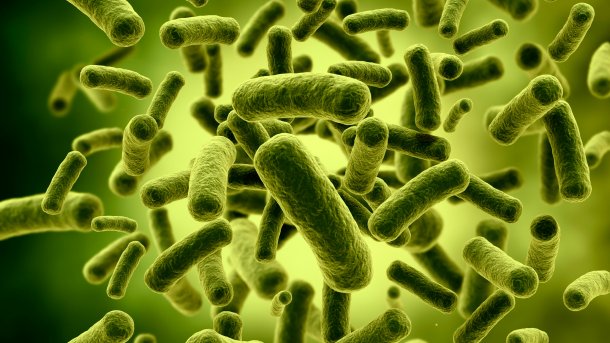Microbes in the gut: it's all about the right mix
With an artificial intestinal flora, US researchers want to better understand the interplay between bacteria and their hosts - and develop targeted therapies.

(Bild: NIH)
(Hier finden Sie die deutsche Version des Beitrags)
The human intestine is an unexplored universe. Up to a trillion bacteria live there, distributed among several hundred species. They are not only important for nutrition, but also have an influence on ageing and diseases such as dementia, autism and heart attacks. But it is difficult to decipher exactly which intricate pathways this so-called "microbiome" uses to interact with the body.
Stanford researchers therefore chose a different approach: instead of trying to understand the chaotic ecosystem in the digestive tract as a whole ("top-down"), they rebuilt it from scratch ("bottom-up"). By specifically adding, changing or omitting certain bacteria, they want to better understand the complex relationships.
The artificial microbial cocktail not only had to take on the same function as a natural bacterial colonisation, for example, breaking down certain food components. Its composition also had to remain stable - the strains were not allowed to displace each other.
Extremely diverse microbiome
Nature was only a partially helpful model in the search for the right recipe: "Two randomly selected individuals share less than half of their microbiome genes," writes Stanford University. To get close to the right mix, Professor Michael Fischbach's team used data from the Human Microbiome Project, which has sequenced the microbiome genes of more than 300 test subjects. From this, they selected the bacterial species that were present in at least 20 percent of the test subjects.
In this way, the researchers came up with a total of 104 strains, which they first cultivated separately in the laboratory. They were then implanted into the previously sterilised intestines of mice in a precisely defined mixing ratio. The result: 98 percent of the species colonised, and even after two months, their relative ratio to each other remained constant.
The next test was to see how robust the artificial colony is against invaders. According to theory, new bacteria should only be able to gain a foothold in a functioning microbiome if they take over functional niches that were not previously occupied. To test this theory, the researchers introduced human stool samples into the intestines of the experimental animals - that is, a bacterial community that had previously proven itself for years. "Some observers thought this would decimate their own colony," says Fischbach. But that was not the case: At the end of the experiment, only about ten percent of the species came from the stool transplant.
Treatments against diseases
In the next round of experiments, the research team omitted the failed strains and included the newly added ones in their synthetic microbiome, which now comprised 119 strains. This made the mice even more resistant to infection by foreign strains, such as pathogenic Escherichia coli germs. Otherwise, the mice with an artificial microbiome behaved in exactly the same way as experimental animals with natural intestinal flora.
In further studies, Fischbach and his team now want to narrow down which bacteria are most important for a resistant microbiome. The recipe will also be made available to other research groups. The long-term goal is targeted microbiome treatments against infections, cancer, obesity or neuro-diseases. Currently, only the entire stool of healthy people is transplanted as a therapy.
(grh)